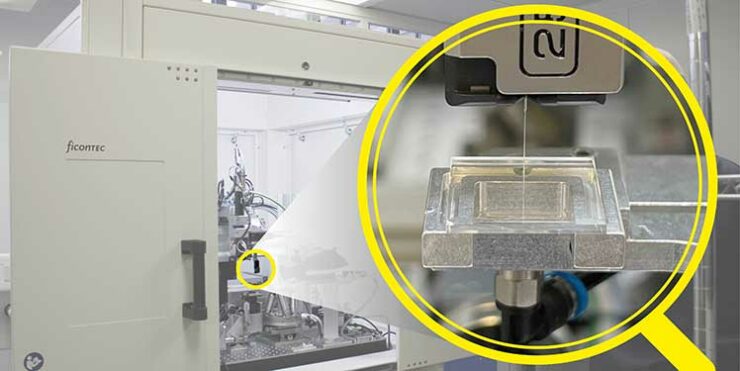Fused silica may be expensive and complicated to produce, but the laser welding process developed at Fraunhofer IZM, which uses it as a connection for photonic chips, is something of a revolution. Welding with a CO2 laser enables robust and long-lasting connections without any adhesives at the optical interface.
Dr. Vanessa Zamora and her team at Fraunhofer IZM are the innovators behind the novel laser welding process which enables optical fibers to be welded directly to photonic integrated circuits (PiC) on fused silica. The use of a CO2 laser is not the only unique choice of the Eurostar project PICWeld. The project also uses fused silica whose adjusted coefficient of thermal expansion and its good compatibility with processes like laser welding make the material a better choice than more familiar interconnection options.
Interconnections for PiCs previously relied on an adhesive process. However, as Vanessa Zamora explains, the adhesive would decarbonize more often than not. “And the whole interconnect has to be replaced,” the scientist continues. For this reason, more and more clients are calling on her and her team to use processes with fused silica. Although this glass is expensive, the compounds would last longer and thus be more sustainable and cost-efficient in the long run.
Fused silica consists of 100% silicon dioxide (SiO2) in a non-crystalline state. Its purity makes it difficult to manufacture as the most expensive of the five common types of glass. One advantage is the material’s high temperature stability, as it can withstand temperatures of up to 1,200°C for brief periods of time. In addition, fused silica is characterized by an excellent coefficient of thermal expansion and good compatibility with processes like laser welding to create fiber joints.
New CO2 laser welding process
Creating fused silica fiber joints is not easy. That is why Vanessa Zamora developed an innovative welding process that uses a CO2 laser. It means that the creation of direct connections can be automated and scaled up, the scientist tells RealIZM. She mentions other advantages as well: “The CO2 laser allows connections to be made quickly and cost-effectively. It is also more compact compared to other lasers, such as the femtosecond laser. Furthermore, it gets you one step further and lets you connect several fibers to a waveguide-based PiC (using a fused silica substrate) in a robust and reliable way.”
Two lasers are used for the welding process. One of them is used exclusively for heating the substrate locally. This is essential, as only the combination of preheating and laser welding makes it possible to interconnect fused silica with fused silica, as Zamora explains.
CO2 laser welding allows the formation of direct fiber connections to be automated and scaled up and avoids the use of adhesives or other filler material at the optical interface. This guarantees a stable connection, which can be produced quickly and cost-effectively.
In future projects, the scientists want to combine arrays of fibers with PiC. These PiC should then be able to operate at extremely high or low temperatures. Quantum technology is one area driving much of the interest in this technology, because “all experiments in quantum physics take place at very low temperatures. There, too, you have the issue of compounds that do not last long enough. Our process could be applied in the very near future.” The automotive industry could also benefit from the fused silica laser welding process developed at Fraunhofer IZM, as the miniaturized photonic systems in automotive applications would sometimes run very hot and again need particularly robust fiber connections.
If you liked the article, please share it on LinkedIn, Twitter, Instagram or Facebook. If you have something to say, we welcome your comments.





Add comment